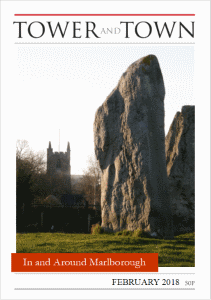

Tower and Town, February 2018 (view the full edition) (view the full edition)Memories Of A Misspent YouthI was born in Chiminage Close, Blowhorn Street, in 1943. My dad was Richard (Dick) Milsom, a plumber and my mum (Hilda) was from a farm workers' family in Downton. The family have been in Marlborough for six generations. I had two older sisters and two younger brothers and on my fifth birthday in 1948 the family moved from Chiminage Close to St Margaret's Mead. This occurred because Doctor Tim was persuaded that a move from the cold and draughty Chiminage Close house to the lower down and still under-construction St Margaret's Mead would benefit my recurring croup. The removal to 'The Mead' was carried out by Mr Perry who had a haulage business and home in London Road. Quite a thrill for a five-year old to ride in the lorry! Dad never learned to drive so rides other than on a bus were rare treats which only happened when uncles visited. Five Stiles Road had yet to be built and the Mead ended where the Recreation Ground begins. The land between there and the railway cutting was farmed by Mr Strong. He also owned the shop which stood on the corner of Salisbury Road and George Lane. Mrs Strong ran the shop. Until Five Stiles Road was built, at harvest time we would chase rats and rabbits as Mr Strong's corn was threshed by a machine driven by a traction engine. Near the Strong's shop and almost opposite the Roman Catholic Church was a forge where we would watch the blacksmith about his work. Situated as it is between Savernake Forest and the Kennet, St Margaret's Mead was a paradise for the many kids who lived there. We roamed the forest and paddled in the Kennet in Stonebridge Lane. When it snowed we sledged on the hill above the Mead or better still down Butterfly Alley on Granham Hill. There was of course the risk that the more reckless could find themselves in the railway cutting or, at Butterfly Alley, in the Kennet. The hill in Stonebridge Lane was our soap box cart race track. The aim was to start at the top and cross the bridge. No pram or pedestrian was safe. The forest was our adventure playground and the source of much firewood when fuel was expensive and smoke free zones non-existent. Youngsters dragging huge branches down the road attracted no comment or attention from the police, which seems extraordinary these days. There were rules, however. We only took wood from fallen trees, of which there always seemed to be one, and never from standing ones - green wood doesn't burn very well. There were traces of the Second War in the Forest. Ammunition could be found along Long Harry where there had been ammunition stores. This was (terrifyingly) much sought after by us children. To be continued in a subsequent issue. The complete memoir is on the Tower and Town website. James Milsom |